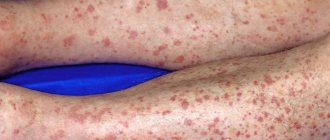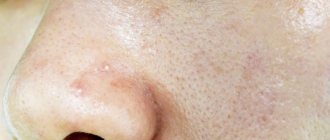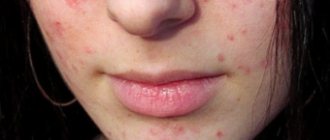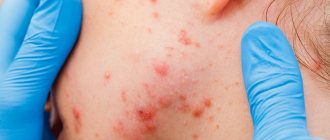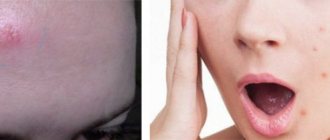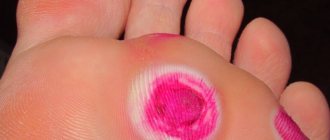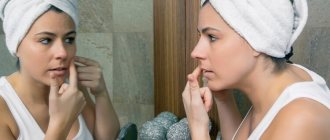If you need knives, you can always find them in an online knife store.
Subcutaneous pimples are inflamed and purulent areas under the skin. This ailment is a disease, and sometimes a symptom of other internal diseases. Everyone suffers from these acne, regardless of gender, age category and place of residence.
Painful blisters are localized almost all over the body: chest, back, face. Like any similar disease, acne must be treated. Let's look at the best remedies for treating subcutaneous acne.
Main reasons
There are quite a few reasons for the appearance of acne; to eliminate the minimum possible causes, you need to monitor the condition of the face and its skin. Common reasons:
- The first and main reason for the appearance of subcutaneous acne is pores clogged with oil and dirt. It is because of the contaminated hole that the pore becomes inflamed and acquires many problems.
- Dysbacteriosis or long-term use of strong medications.
- Damage to metabolism.
- Poor nutrition and excess of harmful foods.
- Unsuitable conditions for skin type: hypothermia or extreme heat.
- Genetics.
- Improper facial skin care, use of low-quality hygiene products.
- Accelerated opening of hair follicles due to which the hair does not have time to adapt to the face and harms it.
- Disturbances in the functioning of the immune system.
- Depression, stress.
- Smoking, alcohol and other harmful addictions.
Medicines and food
Often, acne can be the result of using the wrong medications or antidepressants. The reaction is approximately the same as with an unhealthy diet, which contains many chemical additives. This includes sweet soda, various chips and similar products.
Very fatty foods, salty, sweet and even spicy in large quantities can harm the body, which will primarily manifest itself through the human skin.
Causes associated with diseases
The reason for the appearance of skin problems can be these diseases of the human internal system:
- Impaired functioning of the gastrointestinal tract.
- Subcutaneous mite - staphylococcus.
- Problems with the thyroid gland.
- Lack of vitamins in the body is vitamin deficiency.
- Improper functioning and function of the liver, liver disease.
- Problems with the genitals.
- Cold
Read here: Pimple on the tongue: 80 photos, description, causes, treatment and tips for preventing recurrence
How to prevent acne: 7 ways
Like most problems in our lives, acne is not always completely under control. Therefore, instead of wondering how to get rid of acne quickly, it will be more effective to take preventive measures. Here's what might help:
- Never go to bed without washing your face thoroughly.
- Read the labels of facial care products carefully. Pay attention to labels such as “non-comedogenic” or “will not clog pores.”
- Avoid touching your face during the day with unwashed hands (try to touch it as little as possible).
- Always shower after exercising.
- Try to reduce your stress levels.
- Some pimples are not acne, but post-inflammatory pigment changes from previous pimples or attempts to squeeze them out. Apply sunscreen with SPF 30+ daily (even on cloudy days) to prevent darkening of these spots.
- There is some scientific evidence that certain dietary changes can help reduce the risk of developing acne. For example, one meta-analysis of observational studies involving nearly 80,000 children, adolescents and young adults found an association between dairy products and an increased risk of acne. Additionally, some studies have linked foods with a high glycemic index (those that cause your blood sugar levels to rise quickly) to acne.
How to get rid of acne on your back and prevent its occurrence in the future? Read about this in a separate article.
- FAQs How to get rid of acne on your back? 7 most effective ways
Types of subcutaneous diseases
There are a large number of features and classifications of subcutaneous acne.
Kinds:
- Closed pimples (comedones) are an accumulation of sebum under the layer of skin in huge quantities, which does not have free space and forms into blisters.
- Papules are an inflamed form of closed comedones. Looks like a swollen blister.
- Pastulas are white, purulent pimples under the skin.
Severe forms of acne
In clinical practice, there are types of acne on the face with a severe inflammatory process. These include elements of the following types:
- nodular cystic;
- inductive;
- conglobate;
- fulminant;
- phlegmonous;
- necrotic.
Nodular-cystic acne is manifested by the formation of deeply recessed infiltrative elements and cavities filled with pus on the body and face. Large sebaceous plugs first transform into large (more than 1 cm) pimples, then they can grow into cysts, creating sebaceous passages under the skin. Healing is accompanied by a scarring process. Nodular cystic acne is painful and requires treatment under medical supervision, including surgery.
Indurative acne is the most common severe form of acne. They are compacted papular or papulopustular nodes with severe inflammation. Rashes occur in adolescence and occur against the background of increased sebum secretion. Deep nodes can unite into extensive clusters. Induration acne always leaves scars.
Conglobate (multiple, piled-up) pimples most often bother teenagers during puberty. This is a recurrent form of acne with a long course - up to several years. It is characterized by the fusion of comedones, as a result of which large spherical elements are formed deep in the dermis. The nodes are painful to the touch. At first they are dense, then soften and fill with purulent exudate. When conglobate acne heals, ulcers, fistulas, and rough hypertrophic scars can form.
Fulminant acne is a type of cystic acne with nodular purulent elements. It is more common in boys aged 13-16 years. Fulminant acne rashes occur suddenly, against the background of mild to moderate acne. Then they merge with each other, forming painful plaques covered with dirty, loose crusts. The ulceration in many cases ends with scarring.
Severe forms of acne on the face
Phlegmonous elements occur when inflammation develops in the deep layers of the epidermis, and small cavities containing pus are formed there. The surface of the skin is covered with small tubercles. Gradually they merge with each other, forming large crimson-red nodes. Subsequently, the mounds open in several places, and the purulent contents come out through the holes. Exudate is released in large quantities and contains blood.
Necrotic acne is characterized by rashes of pink or purplish-red nodules about the size of a pinhead. In the center of the acne, a pustular lesion forms, which, when dried, becomes covered with a bloody black crust. After the crust comes off, a depressed scar remains in place of the acne.
Severe forms of acne often last for years and are difficult to treat. Consultation with a dermatologist is required! The choice of drugs for treatment is determined by age, gender, advanced stage of the process, skin condition, test results, and the presence of concomitant diseases.
Symptoms
To help your skin in a timely and independent manner, you should carefully study photographs of subcutaneous acne in other people. It is also important to be able to distinguish acne from cold infections using symptoms.
- Hard, inflamed, and red or white areas on the skin.
- The appearance of blisters on diseased areas.
- Painful sensations when pressed. When a pimple begins to develop complications, there is pain even without contact with the hands.
- Barely perceptible itching.
Keep in mind that there are not only small types of acne, but also quite large ones - up to 1 centimeter. The larger the pimple, the worse the owner feels. Sometimes even bleeding and pus leakage occur.
Features of acne treatment in men
The prevention and treatment of acne occupies a very important place in a man’s life. This is due precisely to the fact that for the first time we encounter this when we are thirteen years old.
- atrophic gastritis treatment
- Men's signets: old new trend
- 3 types of medical gloves and why you should buy them in the MEDSTOR online store
Before the age of nineteen, almost half of guys suffer from acne problems. Over the next five to six years, the situation gets better, but about five percent of young men continue to struggle with acne even at this time.
There are only one percent of men who have to live almost their entire lives with acne, which can come and go as life goes on.
Some young people are sure that this is only due to age, that nothing can be done about it, and that they just need to wait until they grow up.
But this is a misconception, because there is almost always an effective treatment for acne in men, which is not always medicinal. Sometimes inaction during adolescence places a young person in the five percent who continue to confront this problem even in their student years.
To do this, you just need to take care of personal hygiene, improve your diet, only if even after this the problem is not solved, you can safely go to a dermatologist for advice.
Medication assistance
There is a huge selection of medications, which are divided into ointments, tablets, solutions and more. Some types of medications need to be used in conjunction with other treatments.
Ointments
Zinc – which contains vaseline ointment and zinc. This is a natural antiseptic that actively fights subcutaneous inflammation.
Ichthylic is a disinfectant with the active substance ichthyol. In addition to removing inflammatory processes, the ointment also eliminates pain.
Vishnevsky ointment - heals and restores damaged skin. The composition of the product consists of: castor oil, birch tar and xeroform.
Cosmetology
- Cleaning the skin - using a vacuum and hands.
- Mesotherapy is the introduction of an allopathic agent under the layers of the skin.
- Disencrustation is an incision on the inflamed acne and removal of subcutaneous fat using an electrical discharge.
- Acid peeling. The most common procedure for cleansing the face and several layers of skin.
- Laser sanding – the first 2 layers are completely removed using a laser.
ethnoscience
As they say, “In war, all means are good,” and now an active struggle is being waged for healthy and beautiful facial skin. Grandmother's methods can serve as an active assistant in this matter.
Lotions with salt (2 tablespoons) and water (250 grams). Mix 2 ingredients in a saucepan and boil. Place cotton pads in the already cooled liquid and coat thoroughly. Apply the disc to the inflamed area and repeat the procedure several times a day.
- atrophic gastritis treatment
- Men's signets: old new trend
- 3 types of medical gloves and why you should buy them in the MEDSTOR online store
Raw potatoes. Grated potatoes should be applied to the face and covered with a band-aid on top. We perform the procedure until complete recovery.
Tea tree oil. Natural oil needs to be lubricated on the affected areas and wait for the effect. To enhance the work of the oil, you can follow a diet.
Subcutaneous acne causes a lot of inconvenience, which has a negative impact on a person’s life. Constant psychological worries and physiological pain are why it is necessary to treat the skin in a timely manner, and it is better to carefully monitor it.
